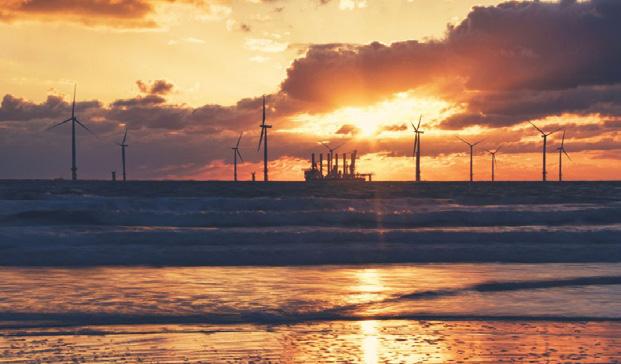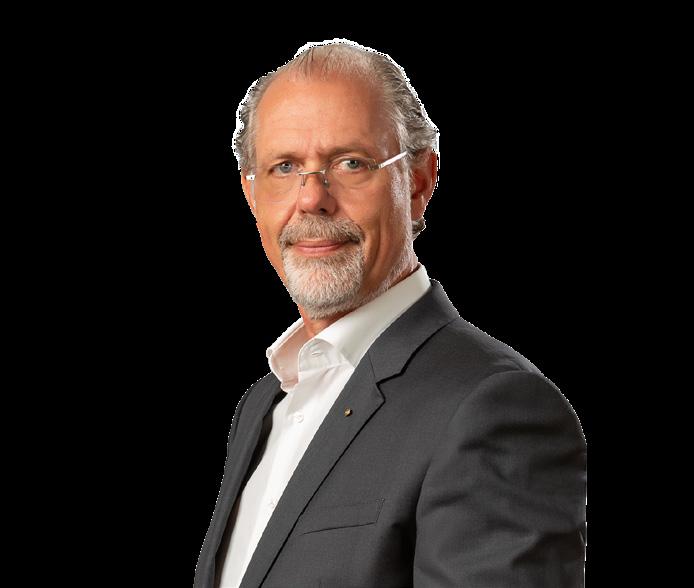
8 minute read
Optimising
OPTIMISING OFFSHORE WIND
The GAC Group(1), a global shipping, logistics and offshore support provider, highlights the advance of the offshore wind sector, the logistical challenges and solutions
Offshore wind energy is storming ahead in Northern Europe, partly due to initiatives put into place when moving away from fossil fuels became an international priority. However, more immediate pressures, such as a drive towards economic diversification and de-coupling from reliance on imported gas, are adding impetus to that momentum.
The European Union (EU) has firmly planted its flags in the offshore camp. In May, President of the European Commission Ursula von der Leyen, German Chancellor Olaf Scholz and the prime ministers of Denmark, Belgium and the Netherlands met in the Danish Port of Esbjerg – one of Europe’s major offshore wind ports – to formally establish a shared commitment to develop offshore wind infrastructure in the North Sea.
The Esbjerg Declaration included a commitment to expand joint offshore wind projects, energy islands and offshore grids to achieve a combined North Sea offshore wind capacity of 65 Gigawatts (GW) by 2030 and 150 GW by 2050.
The presence of the European Commission President highlights the significance of offshore investments for the EU. Offshore wind projects, electric vehicles and hyperlocalisation are all part of the EU’s drive to reach net-zero greenhouse gas (GHG) emissions by 2050.
Member countries’ fossil fuel combustion is by far the largest source of GHG emissions at 80 per cent. Transportation amounts to 28 per cent of carbon output, while 26 per cent comes from industry, 23 per cent from power, 13 per cent from buildings and another 13 per cent from agriculture.
Wind energy is central to achieving the EU’s goal. A wind farm converts kinetic energy into rotary mechanical energy, and in more advanced models, a generator transforms rotational energy into electricity. This electricity generation method has been shown to be competitive when compared with combustion-based fuel sources.
Economic reservations regarding wind and other renewable energy sources have been repudiated by their rapid price drop over the last decade. In 2021, 163 GW – nearly two-thirds of new renewable power – generated undercut the cheapest coal-fired power plants in G20 countries. Moreover, renewable resources like wind and solar can be used almost anywhere. Access to those renewable sources cannot be blocked or restricted – something which offers countries and communities worldwide potential energy independence.
SHARED GOAL
“Service providers can play a significant role in the shift towards expanding the offshore sector,” says Erland Ebbersten, Group Vice President, Marine & Energy at GAC Group, a global shipping, logistics and offshore support provider. “An embryonic, determined drive towards sustainability means providers and the industry can work together for a shared goal.”
Western and Northern Europe are already dedicated to the green shift – Sweden and Denmark have pledged to
(1) GAC has a tradition of transferring knowledge and expertise across offices globally to deliver tailored, flexible and adaptable solutions to meet customer requirements. This global knowledge, teamed with local support, is a valuable commodity in the renewable energy sector which is more competitive than traditional oil and gas, and where local contracting is more prevalent. become fossil fuel-free by 2040 and 2050 respectively while Germany aims to fulfil all its electricity needs through renewable sources by 2035.
“Expertise is crucial in supporting Europe’s energy transition and GAC is in a good position to provide just that,” adds Erland. “With decades of experience serving the energy sector, we have proven our strength, expertise and reliability as a partner to our customers.”
8 Hard-earnt
expertise in offshore oil & gas rig set-up and operations can be transferred to the offshore wind sector with ports playing a key role in the logistics chain
LOGISTICAL CHALLENGES
Finance and politics are not the only hurdles in the race to achieve the EU’s renewable energy ambitions. The physical means of installing gigantic windmill structures in deep sea water is a significant operational challenge. Weather can impact the speed of installation and transshipment errors can occur when loading and transporting large wind farm components from land to sea.
More difficulties and considerations arise after wind farm structures are installed. These include the shortage of wind farm installation vessels, harsh weather stalling repairs, weather erosion having a long-term weakening effect on turbine blade robustness and the technical considerations behind engines which must be uniquely designed to be operational for decades following installation.
Of the entire cost of offshore wind farm annual operational expenditure costs, 17 per cent goes toward logistics alone, according to scientific journal Energies. Operational expenditure is the most significant cost component of wind farm maintenance.
Cost-effective, reliable logistics support therefore plays a fundamental role in wind farm installation and maintenance, serving as an ocean floor into which the pole of global sustainability is lodged.
This applies to the technical requirements of managing offshore projects such as vessel clearance with customs, transport of equipment and spare parts, agency service for supplies and personnel and 24/7 point-of-contact service for all contractors involved.
Optimising logistics effectiveness reduces powergeneration costs and, thus, electricity prices. This goal has become even more prescient amid the global energy crisis.
ROLE OF OFFSHORE WIND PORTS
Ports play numerous roles in facilitating offshore activities. Certain terminals cover the entire wind energy value chain while others target individual services within the local and international supply chains, logistics and supporting infrastructure, such as pre-assembly, installation, maintenance, storage and components transit.
The primary operation and maintenance of offshore wind farms take place in ports which facilitate the transportation of essential parts such as wind turbines and other equipment. They are also where floating turbines are assembled, highlighting a future role in supporting the innovative factor in offshore development.
New offshore wind farms with a capacity of about 3 GW are deployed by European ports annually. To meet 2030 targets, authorities plan for new offshore projects with a capacity of 25 GW with 15,000 turbines serviced every year.
Port capacity can support the intended growth of offshore provided there is significant investment in developing the necessary infrastructure such as land, quays, and deep-sea berths. This facilitates not just the materials coming in and out of terminals but also the operations for larger fleets for future decommissioning projects and manufacturing hubs. Diversification of ports in this sector also means they can support the rapidly encroaching decarbonisation of the global shipping industry.
Improving port infrastructure would typically be solely the concern of local, regional and national governments. However, given the central role of ports in meeting pressing international offshore renewable energy aims, cooperation between EU authorities, the private sector and logistical support provision is imperative.
TRANSFERABLE SKILLS
A legacy benefit of moving away from fossil fuels and into renewables is that the experience can be used in different geographies and newer industries.
The support provided for offshore oil & gas rig operations mirror those needed for offshore wind farms. This includes seismic surveys, crew transportation, provision of offshore living quarters and acting as a supply house for equipment and tools.
This year, GAC Denmark aided the decommissioning of a 250-metre-long Floating Production Storage and Offloading (FPSO) vessel and its associated mooring systems, risers and dynamic umbilicals. The expertise is now being transferred to and applied on other offshore sustainability projects supported by GAC in the North Sea and Northern European countries such as Norway.
The importance of cost savings means that experience and assets need to be well-placed to meet the high demand in the renewables sector as they develop in different parts of the world.
The United Kingdom (UK) is a rising market for renewables and home to the largest wind farms in the world, which have popped up over the last 10 years. This has translated directly into opportunities for local logistics providers, with GAC actively involved in offshore wind farms in the UK, reciprocating directly to oil & gas contractors moving into the wind market.
Innovation in the sector is simultaneously being promoted, with floating offshore wind farms offering several benefits over fixed equivalents. First, they can be cost-effectively installed anywhere, in deeper seas, thus harnessing more power.
The UK’s latest and highest capacity floating offshore wind farm, the 50 MW Kincardine installation, is expected to generate up to 218 GWh of electricity annually – enough to power about

55,000 homes. However, these new developments still require logistics support, particularly with FPSOs.
Optimistically, the evolution of the offshore wind market in Europe demonstrates how the existing oil & gas infrastructure can serve as a launching pad towards sustainability instead of starting from scratch.
This comes as firms in Asia look to leverage the experience of experts based in the region, especially in specialist fields such as seismic surveys. In addition, a local presence in the area is essential to identifying local ports to use as marshalling points for jacket foundations and other heavy components for installing offshore wind projects.
Southeast Asia followed in Europe’s footsteps five years ago when it began to expand renewable energy and end its dependence on GHG emissions – partly the imperative for GAC’s presence and upcoming expansion in the region.
Firms and national governments generally agree that Asia is a sustainability boom waiting to happen, with opportunities for growing and emerging economies to serve as a leveller for energy demands and requirements.
Wherever they are in the world, there is a hierarchy of logistics which goes into making global offshore wind projects function. In the same way that political and financial drivers cannot be separated from the world’s existential need to expand sustainable energy sources, the operational factors at the port and sea, such as expertise and scope, are just as critical. And at times like this, having a good and reliable service provider can help you navigate through challenges in your energy projects smoothly and effectively.
“At a time when the offshore support sector is facing the challenges of spiralling costs and growing demand, our role as a provider of integrated services is even more important as we all work together towards transforming the energy market,” says Erland.
8 Expertise is








